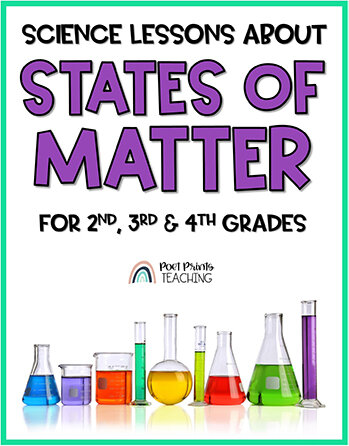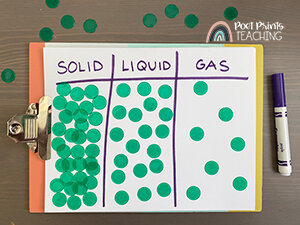States of Matter Activities for Kids
States of Matter is the one concept that repeats over and over in our science curriculum up here in British Columbia. Understanding particles really is so fundamental to so much of chemistry, physics… and science in general! So, I understand the repetition! Take a peek at the states of matter activities and lessons that have been the most successful in second and third grade!
Text: States of Matter for 2nd, 3rd, and 4th Grades
Image: A series of colorful beakers are displayed on a white surface.
What is matter and what is it made of?
“What is Matter” anchor chart.
When we start introducing the concept of ‘matter’ to students, we start with a simple anchor chart, like this one. Almost everything around us is made of matter. You are made of matter! I am made of matter! This desk is made of matter. Anything we can touch and hold is made of matter (We do talk about how thoughts, and feelings are not made of matter). Matter is made of teeny tiny particles called atoms.
There are 3 states of matter
Next, we talk about how matter exists in three states: solid, liquid, and gas. Solids keep their shape. Liquids take the shape of their container. And gasses expand to fill the whole space (or container). There are a couple of hands-on ways we explore these three.
First, I’ll write these 3 definitions on the board or on three separate papers. Before we even create an anchor chart, we will start sorting tangible items in our room. This is a ‘get up and move activity. Together, we’ll grab objects and start sorting them into categories. (HINT: blow up a few balloons ahead of time so you have a ‘gas’ or two to sort!)
If I don’t want to use physical objects, we’ve also done a card-based sorting game. This one is fun because it’s easy to make a copy so small groups of students each have their own deck to sort. It’s also easy to use as an exit ticket at the end of a science class. I’ll just hold up a card and ask them to tell me if it’s a solid, liquid, or gas!
This card-based sorting game comes from my Matter for Little Learners science unit. It was super easy to print out a few decks of sorting cards and play the game in small groups around the classroom.
The particles in a solid, liquid, or gas are different
All matter is made of teeny, tiny particles called atoms and the atoms in a solid, liquid, and gas are different from each other. There are a few ways I teach this process in second and third grades:
See the particles with a simple activity…
A simple activity template to show the particles in a solid, liquid and a gas.
Using a simple template (you can also just draw and photocopy a template like this) we show what the particles look like in each state of matter. Solids have particles tightly packed together. Liquids are more spread out with room to move. Gases are very spread out and move past each other quickly. This is an easy thing to create with whatever you have on hand. In the past, I’ve used cheerios glued to a simple template, bingo dabbers on cardstock paper, sequins glued on paper, etc. There is no ‘right’ material to use as the atom!
Act out the particles…
In this version, each student becomes an ‘atom’. (This may work best outside) Use string or yellow traffic cones to create a circle on the floor barely big enough to fit all of your students standing up. Ask all students to stand inside. Pack them in tightly so they are barely able to move. “You are now a solid! Atoms in a solid are tightly packed but cannot move past each other. They can wiggle a little from side to side, but that’s it!”
Now, make the circle a little bigger. This time the students might be able to walk slowly past each other to change spots. “You are now a liquid! Atoms in a liquid have some room to move carefully past each other.”
Now, make the circle MUCH larger. The students should have space to jog/run. Ideally, this would be done on a field or in a gymnasium. “You are now a gas! Atoms in a gas move freely at high speeds and take up all of the space they are given.”
Let me do your planning
Looking for a whole unit? I have you covered whether you are just introducing little learners to the concept of matter or getting a little more in-depth with students in third or fourth grades. Units are full of nonfiction reading, activities, and complete lesson plans. Let me take one piece of lesson planning off of your plate!
Pin me for later!
Text: States of Matter Science Ideas for 2nd, 3rd, and 4th Grades
Image: Three students participate in science activities.





